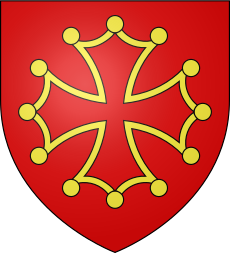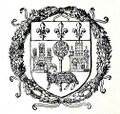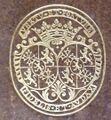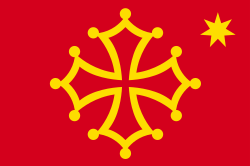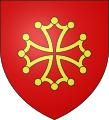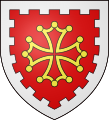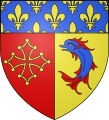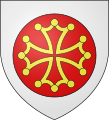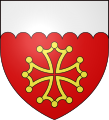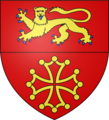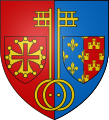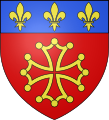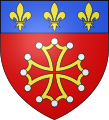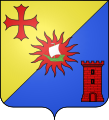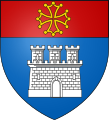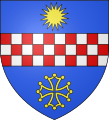الصليب الأوكسيتاني
The Occitan cross (also called cross of Occitania, cross of Languedoc, cross of Toulouse;[1] heraldically cross cleché, pommetty and voided) is a heraldic cross, today chiefly used as a symbol of Occitania.
The design was probably first used in the coat of arms of the counts of Forcalquier (in modern Provence), in the 12th century,[بحاجة لمصدر] and by the counts of Toulouse in their capacity as Marquises of Provence, on 13th century coins and seals. It later spread to the other provinces of Occitania, namely Provence, Guyenne, Gascony, Dauphiné, Auvergne and Limousin.
A yellow Occitan cross on a blood-red background with the seven-armed golden star of the Felibritge makes up the flag of modern-day Occitania. It can also be found in the emblems of Midi-Pyrénées, Languedoc-Roussillon and Hautes-Alpes, among many others, as well as in cemeteries and at country crossroads.
The blazon of the modern emblem is gules, a cross cleché (or: pattée) pommettée voided or ("in a red field, a gold cross 'with keys' (or: 'with paws') and 'with spheres/apples', in outline"; Occitan: de golas a la crotz voidada, clechada (or patèa) e pometada d'aur),[بحاجة لمصدر] also described as cross pattée botonnée, cross pommettée, cross toulouse,[2] or cross fleury voided (or: in skeleton).[3] In the Chanson de la Croisade Albigeoise, it goes by the name of "Raymondine cross" (crotz ramondenca).[4]
. . . . . . . . . . . . . . . . . . . . . . . . . . . . . . . . . . . . . . . . . . . . . . . . . . . . . . . . . . . . . . . . . . . . . . . . . . . . . . . . . . . . . . . . . . . . . . . . . . . . . . . . . . . . . . . . . . . . . . . . . . . . . . . . . . . . . . . . . . . . . . . . . . . . . . . . . . . . . . . . . . . . . . . .
التاريخ

تمت إبادة المذهب المسيحي في فرنسا علي يد الكاثوليك ضمن محاكم التفتيش وإتهامات الهرطقة ..
ولا يبقي إلا صليب ضمن أثار يتخذها القوميون لهم كشعار ..
15th-century depiction of the arms of Toulouse as a voided cross potent.
Late medieval depiction as the coat of arms of the Mozzi family of Florence, in Palazzo Mozzi.
Arms of the count of Toulouse (1509)
Toulouse arms from the time of Henry IV of France (r. 1572–1610)
الاستخدامات الحديثة
البلد
العلم الحديث لـ أوكسيتانيا (tanben existís una version sens l'estela)
المناطق
ancian comtat de Forcauquier, ancian Marquesat de Provença, Lengadòc (ancian comtat de Tolosa)
Drapèl de la Val d'Aran
Drapèl de Lengadòc-Rosselhon
Drapèl de Miègjorn-Pirenèus
Lògo de Miègjorn-Pirenèus
الأقاليم
Escut d'Aude
Escut dels Auts Aups
Escut d'Erau
Escut de Gard
Escut de la Nauta Garona
Escut de Tarn
Escut de Tarn e Garona
المدن والبلدات
Blanhac، Lengadòc
Fanjaus، Lengadòc
Moissac، Carcin
La Novèla، Lengadòc
Sant Deidier، Provença
Los Sarrasins، Lengadòc
تولوز، Lengadòc
Travalhan، Provença
Venasca، Provença
الخارج
شعار نادي تولوز
Senhalizacion a تولوز
متفرقات
- شعار نادي تولوز
- Place du Capitole, Toulouse[5] 43°36′16″N 1°26′36″E / 43.604389°N 1.443361°E)
- درع La Tour d'Auvergne
- Street signs in Toulouse
- Roadsigns in Limousin[6]
- Sign of the Conseil Interprofessionnel des Vins du Languedoc[7]
انظر أيضاً
الهامش
- ^ After the coat of arms of the counts of Toulouse. "The first known Cross of Toulouse is shown on Count Raimond VI's seal, dated from 1211. Then widely used all over Languedoc, the Cross of Toulouse appeared on the municipal arms of Toulouse and the provincial arms of Languedoc in the 14th century. Pierre Saliès (Archistra, December 1994) claims that the Cross of Toulouse is a modification of the Latin Cross, attributed to Count Raimond VI. In 1099, Raimond VI took part to the reconquest of Jerusalem with the Crusaders. As a Crusaders' chief, Raimond would have adapted a cross slightly different from the Latin Cross bore by the low-rank Crusaders. According to this theory, the edges of the arms of the cross were cut into two pieces and curved. To be fixed on a shield, such a cross required twelve rivets. The design would have progressively evolved towards the Cross of Toulouse." (Ivan Sache, 24 April 2003, crwflags.com)
- ^ Thomas Robson, The British Herald (1830), p. 336.
- ^ Catherine Lucy Wilhelmina Powlett Duchess of Cleveland, The Battle Abbey Roll vol. 3 (1889), p. 182.
- ^ La Cançon de la crosada, laisse 109 (v. 2300), Per la crotz Ramondenca que contral vent resplant, see L. Macé in: Marcus Graham Bull, Catherine Léglu (eds.), The World of Eleanor of Aquitaine: Literature and Society in Southern France Between the Eleventh and Thirteenth Centuries (2005), p. 152.
- ^ "Archived copy". Archived from the original on 2007-09-27. Retrieved 2007-05-30.
{{cite web}}: CS1 maint: archived copy as title (link) - ^ "Archived copy". Archived from the original on 2008-11-12. Retrieved 2007-06-09.
{{cite web}}: CS1 maint: archived copy as title (link) - ^ "L'AOC Languedoc fête ses 30 ans !". languedoc-wines.com. Retrieved 31 December 2016.
- Les Comtes de Toulouse et leur entourage: Rivalités, alliances et jeux de pouvoir XIIe-XIIIe siècles by Laurent Macé (éd. Privat)قالب:Year needed
- La Croix occitane by Bertran de la Farge (éd. Loubatières)قالب:Year needed
- Le Pays de Forcalquier by Jean-Yves Royer (éd. Équinoxe)قالب:Year needed
وصلات خارجية
 Media related to الصليب الأوكسيتاني at Wikimedia Commons
Media related to الصليب الأوكسيتاني at Wikimedia Commons

